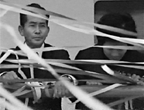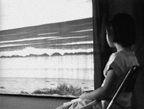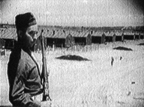Part 6
Okinawan Diaspora / Leaving Okinawa
Okinawa is known for producing multitudes of emigrants. Before World War II, they left to escape the economic crisis known as “Sago Palm Hell” and aid those left behind. After the war, they were scattered by the forced confiscation of their land by the American military. The narratives of their experiences in their new lands were by no means only stories of success. While living in foreign countries, these people became much more conscious of their identities, aware that they had been Okinawans before they were Japanese. The present day, the modern times experienced by these Okinawan exiles. Light and shadow. Nostalgia and the sea. We see the traces of the Okinawan diaspora.
 Leaving Port: Okinawa
Leaving Port: Okinawa
(“Funade: Okinawa hen”)- 1972 / Color / Video / 25 min
Director: Ikematsu Toshio
Photography: Takabatake Tsuneo
Production Company, Source: Nippon Television Network Corporation (NTV)
Broadcast Date: January 16, 1972
Just before the reversion of Okinawa to Japan, on February 15, 1971, Nakaoji Seicho and eleven members of his family were poised to emigrate to Sao Paulo. Along with sixty-four other members of eleven different families, they made up the first wave of Brazil-bound emigrants transplanted after the war. The TV documentary follows the Nakaoji family as they say their last goodbyes, and set off on their journey. Brazil shows their lives post-emigration, and A Return to Japan depicts their return to Okinawa fifteen years later.
Okinauense: Okinawans Living in Latin America <In Bolivia>
(“Okinauense: Raten America ni ikiru Okinawaken jin <Boribia hen>”)- 1977 / Color / Video / 25 min
Okinauense: Okinawans Living in Latin America <In Peru>
(“Okinauense: Raten America ni ikiru Okinawaken jin <Peru hen>”) 1977 / Color / Video / 25 min
1977 / Color / Video / 25 min
Director, Narrator: Inafuku Kenzo
Production Company, Source: Ryukyu Broadcasting Corporation (RBC)
In Latin America Okinawans are called okinauense. This series focuses on the broken dreams and the dark side of the history of the immigrants, rather than okinauense success stories. In Bolivia is the third program in this series, which was the first time the Ryukyu Broadcasting Corporation (RBC) sent a TV crew overseas for an extended period, and commemorated the twentieth anniversary of its founding. In August 1954 the first camp of 269 immigrants left U.S.-occupied Okinawa for Bolivia and settled on the Uruma Plateau, south of the Rio Grande River. After much hardship, eventually they built three “Colonia Okinawas.” This piece shows life and death, past and present of the immigrants who lived in these three Colonia Okinawas. Riveting camerawork conveys the distinctive characteristics of this series, drawing attention to the graves of those who have fallen with half-fulfilled dreams and others who, at the end of long hardship, find shelter in old people’s homes.
 Hia Sá Sá—Hai Yah!
Hia Sá Sá—Hai Yah!
- BRAZIL / 1985 / Portuguese, Japanese / Color / Video / 27 min
Director, Script: Olga Futemma
Photography: Cesar Charlone
Editing: Sarah Yakhni
Music: Karin Stuckenschmidt
Production Company, Source: Montevídeo e Tapiri Cinematográfica
This short video documentary by a second-generation Okinawan Brazilian visual artist is an “artistic manifesto” about Okinawan immigrant society in Sao Paolo. We hear the voices of nomadic islanders who crossed numerous oceans to arrive at distant shores. Poetic narration and allegorical imagery depict the artistic community in a strange city and old immigrant women’s dreams and memories reinterpreted by young girls, staged on oceans and rivers leading home.
 Memories of Betrayal
Memories of Betrayal
(“Uragiri no kioku”)- 1988 / Color / Video / 25 min
Director: Tsuchie Makiko
Photography: Kasama Hiroyuki, Funakoshi Yoshito, Jinnai Koichi,Nakanishi Tomoaki
Editing: Kasama Hiroyuki
Producer: Taira Naomasa
Production Company, Source: Ryukyu Asahi Broadcasting Corporation (QAB)
During the Pacific War, South Americans of Japanese descent were labeled “war criminals” by the U.S. government and forced into internment camps in the U.S., a fact that was not exposed until 1988. Why were South Americans of Japanese descent grouped with the Japanese? Here the figure of John Emerson, an American diplomat and “friend of Japan,” emerges. This work probes the reasons for the forced internments through evidence from U.S. government documents and officials, and testimony from South Americans of Japanese descent who returned to Okinawa after the war.
